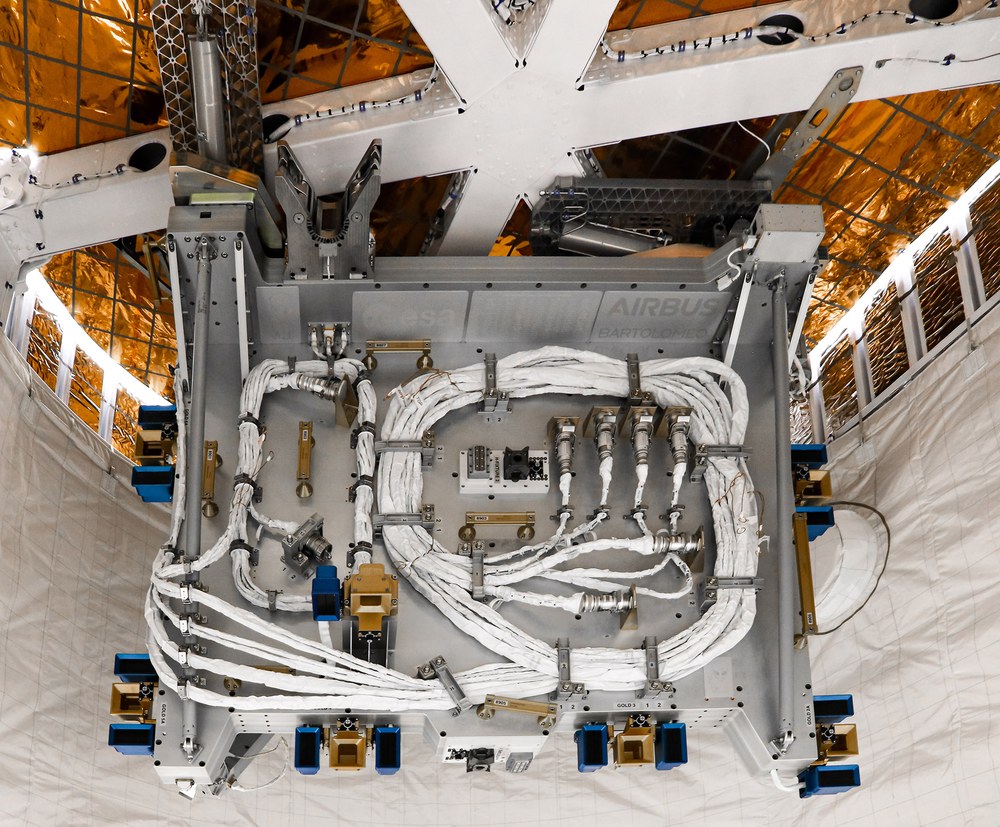Cleared for commercialisation – Bartolomeo external platform to expand usage of the ISS

+++SpaceX CRS-20, carrying Bartolomeo on board, was successfully launched from Florida en route to the ISS on 6 March 2020 at 23:50 EST (local time) - 7 March 2020 at 05:50 CET.+++
Its days on Earth are numbered – the external platform Bartolomeo is currently waiting for its launch to the International Space Station (ISS) at Kennedy Space Center in Florida inside a SpaceX Dragon capsule. "With the 'research balcony' Bartolomeo, the ISS is entering a new era," says Walther Pelzer, Member of the German Aerospace Center (Deutsches Zentrum für Luft- und Raumfahrt; DLR) Executive Board and head of DLR Space Administration. "This project 'made in Germany' is making a significant contribution to the commercialisation of the ISS. Bartolomeo is Europe's first private external platform on the ISS and offers companies and research institutions the unique opportunity to develop their project quickly and easily in space." Following extensive vibration tests at the DLR Institute of Aeroelasticity in Göttingen, and successful final tests in Florida, SpaceX-20 is now set for launch on 6 March 2020. The platform was built by Airbus in Bremen and will be operated jointly with the Columbus Control Center at DLR's site in Oberpfaffenhofen.
An external laboratory to expand the ISS
Named after the younger brother of Christopher Columbus – the explorer and namesake of the European ISS laboratory – Bartolomeo is to be installed this spring as the first commercial platform on the exterior of the aforementioned Columbus laboratory. To do this, the Canadian robotic arm will first move the platform to its destination and attach it there. Two astronauts will then carry out the electrical installation during an extravehicular activity. With its dimensions of two by two and a half metres and a weight of 484 kilograms, the new platform will extend the available space on the ISS by adding a kind of research balcony with 12 payload slots and three antenna positions. The payloads can be around half a cubic metre in size and have an unobstructed view of Earth or space from an altitude of approximately 400 kilometres. Bartolomeo is therefore particularly suitable for experiments that require an open space environment.
A wide range of possible uses
"Radiation biologists, solar physicists and astrophysicists, Earth observers and atmospheric and climate researchers will all benefit from the new platform,” says Julianna Schmitz, who is responsible for ISS commercialisation at the DLR Space Administration. “Bartolomeo is particularly suitable for technology testing and validation. There are unique possibilities here that cannot be achieved in any laboratory on Earth because optical sensors, materials, robotic components and antennas can be tested directly in the space environment." For example, the OSIRIS laser communications terminal of the DLR Institute of Communications and Navigation in Oberpfaffenhofen is also expected to be located on Bartolomeo from 2021. The system was developed in cooperation with the industrial partner TESAT in Backnang, near Stuttgart, and is intended to transmit the constantly growing volume of data from experiments on the ISS quickly and securely down to Earth. In addition to the advantage of testing experiments and technologies directly in space, it is also considerably more cost-effective to conduct these experiments on Bartolomeo than it would be on satellites. They do not require their own rocket launch but rather are accommodated on routine supply flights to the ISS. "This simple and cost-effective operation makes Bartolomeo particularly attractive for small and medium-sized enterprises (SMEs) and can open up new business opportunities for them, for example in the field of telecommunications," explains Schmitz. "No astronauts will need to be deployed to retrofit Bartolomeo with scientific payloads. Thanks to the payloads’ standardised dimensions and interfaces, installation is much easier and can be carried out purely robotically via remote control from Earth." A robotic arm on board the ISS picks up the module at one of the two experiment airlocks and installs it at its location on Bartolomeo.
Tickets for commercial ISS use
Bartolomeo is intended to give commercially motivated experiments quick and simplified access to the ISS. To this end, Airbus, as the manufacturer of Bartolomeo, also sells these flight opportunities to research and industrial organisations. According to Airbus, the annual rent will range between 300,000 to 3.5 million euro depending on the size of the payload. This includes user support for experiment development and safety certification, the flight to the ISS, installation via the robotic arm, experiment operation and finally, data handling. In doing so, Airbus is not only a contractor. The company has invested 40 million euro of its own financial resources in the development, construction and operation of Bartolomeo and has developed the platform in cooperation with the European Space Agency (ESA). Among the ESA member states, Germany is the largest stakeholder in the ISS programme.
Outlook
Bartolomeo was born from ESA's call for ideas on the commercial exploitation of the ISS and is now the second partnership of its kind. The first was the ICE Cubes system for small, standardised payload containers from the Belgian company SAS, which Alexander Gerst installed in the Columbus laboratory during the horizons mission. Further commercial partnerships have already been agreed. ESA reserves 30 percent of its ISS resources for national programmes and commercial services. These are the first steps towards a commercialised use of the ISS and are in line with the commercialisation strategies of its international partners. They should further boost the development of commercial offerings on the ISS and in low Earth orbit and open up their research opportunities to other user groups. In the long term, space agencies hope that this will provide access to the ISS at a lower cost than would be the case if it were operated purely by public institutions.


